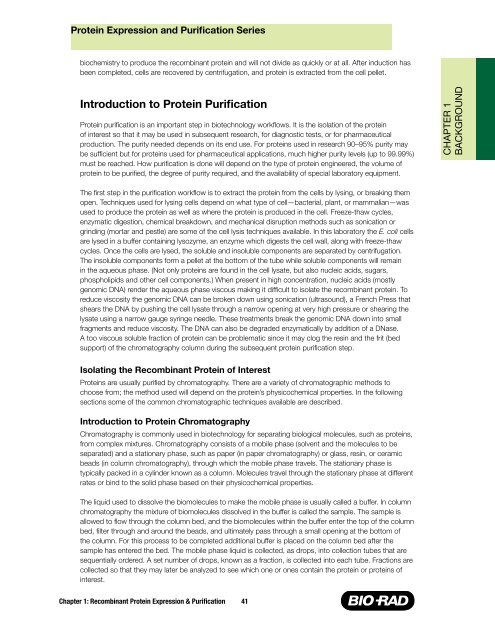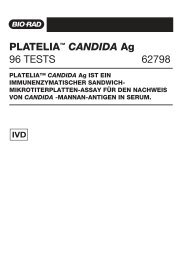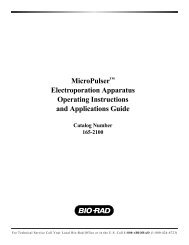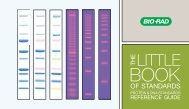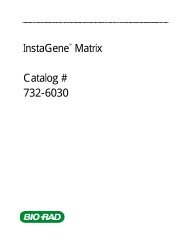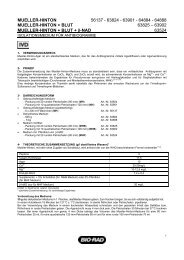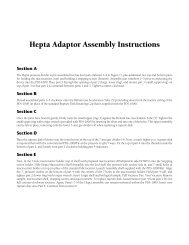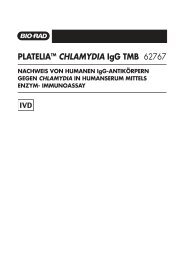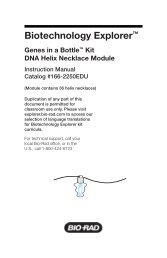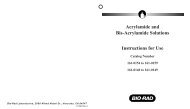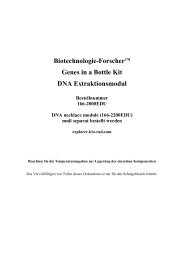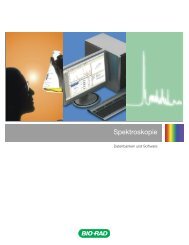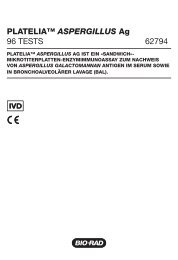Protein Expression and Purification Series - Bio-Rad
Protein Expression and Purification Series - Bio-Rad
Protein Expression and Purification Series - Bio-Rad
You also want an ePaper? Increase the reach of your titles
YUMPU automatically turns print PDFs into web optimized ePapers that Google loves.
<strong>Protein</strong> <strong>Expression</strong> <strong>and</strong> <strong>Purification</strong> <strong>Series</strong><br />
biochemistry to produce the recombinant protein <strong>and</strong> will not divide as quickly or at all. After induction has<br />
been completed, cells are recovered by centrifugation, <strong>and</strong> protein is extracted from the cell pellet.<br />
Introduction to <strong>Protein</strong> <strong>Purification</strong><br />
<strong>Protein</strong> purification is an important step in biotechnology workflows. It is the isolation of the protein<br />
of interest so that it may be used in subsequent research, for diagnostic tests, or for pharmaceutical<br />
production. The purity needed depends on its end use. For proteins used in research 90–95% purity may<br />
be sufficient but for proteins used for pharmaceutical applications, much higher purity levels (up to 99.99%)<br />
must be reached. How purification is done will depend on the type of protein engineered, the volume of<br />
protein to be purified, the degree of purity required, <strong>and</strong> the availability of special laboratory equipment.<br />
The first step in the purification workflow is to extract the protein from the cells by lysing, or breaking them<br />
open. Techniques used for lysing cells depend on what type of cell—bacterial, plant, or mammalian—was<br />
used to produce the protein as well as where the protein is produced in the cell. Freeze-thaw cycles,<br />
enzymatic digestion, chemical breakdown, <strong>and</strong> mechanical disruption methods such as sonication or<br />
grinding (mortar <strong>and</strong> pestle) are some of the cell lysis techniques available. In this laboratory the E. coli cells<br />
are lysed in a buffer containing lysozyme, an enzyme which digests the cell wall, along with freeze-thaw<br />
cycles. Once the cells are lysed, the soluble <strong>and</strong> insoluble components are separated by centrifugation.<br />
The insoluble components form a pellet at the bottom of the tube while soluble components will remain<br />
in the aqueous phase. (Not only proteins are found in the cell lysate, but also nucleic acids, sugars,<br />
phospholipids <strong>and</strong> other cell components.) When present in high concentration, nucleic acids (mostly<br />
genomic DNA) render the aqueous phase viscous making it difficult to isolate the recombinant protein. To<br />
reduce viscosity the genomic DNA can be broken down using sonication (ultrasound), a French Press that<br />
shears the DNA by pushing the cell lysate through a narrow opening at very high pressure or shearing the<br />
lysate using a narrow gauge syringe needle. These treatments break the genomic DNA down into small<br />
fragments <strong>and</strong> reduce viscosity. The DNA can also be degraded enzymatically by addition of a DNase.<br />
A too viscous soluble fraction of protein can be problematic since it may clog the resin <strong>and</strong> the frit (bed<br />
support) of the chromatography column during the subsequent protein purification step.<br />
Isolating the Recombinant <strong>Protein</strong> of Interest<br />
<strong>Protein</strong>s are usually purified by chromatography. There are a variety of chromatographic methods to<br />
choose from; the method used will depend on the protein’s physicochemical properties. In the following<br />
sections some of the common chromatographic techniques available are described.<br />
Introduction to <strong>Protein</strong> Chromatography<br />
Chromatography is commonly used in biotechnology for separating biological molecules, such as proteins,<br />
from complex mixtures. Chromatography consists of a mobile phase (solvent <strong>and</strong> the molecules to be<br />
separated) <strong>and</strong> a stationary phase, such as paper (in paper chromatography) or glass, resin, or ceramic<br />
beads (in column chromatography), through which the mobile phase travels. The stationary phase is<br />
typically packed in a cylinder known as a column. Molecules travel through the stationary phase at different<br />
rates or bind to the solid phase based on their physicochemical properties.<br />
The liquid used to dissolve the biomolecules to make the mobile phase is usually called a buffer. In column<br />
chromatography the mixture of biomolecules dissolved in the buffer is called the sample. The sample is<br />
allowed to flow through the column bed, <strong>and</strong> the biomolecules within the buffer enter the top of the column<br />
bed, filter through <strong>and</strong> around the beads, <strong>and</strong> ultimately pass through a small opening at the bottom of<br />
the column. For this process to be completed additional buffer is placed on the column bed after the<br />
sample has entered the bed. The mobile phase liquid is collected, as drops, into collection tubes that are<br />
sequentially ordered. A set number of drops, known as a fraction, is collected into each tube. Fractions are<br />
collected so that they may later be analyzed to see which one or ones contain the protein or proteins of<br />
interest.<br />
Chapter 1: Recombinant <strong>Protein</strong> <strong>Expression</strong> & <strong>Purification</strong><br />
41<br />
CHAPTER 1<br />
BACKGROUND


